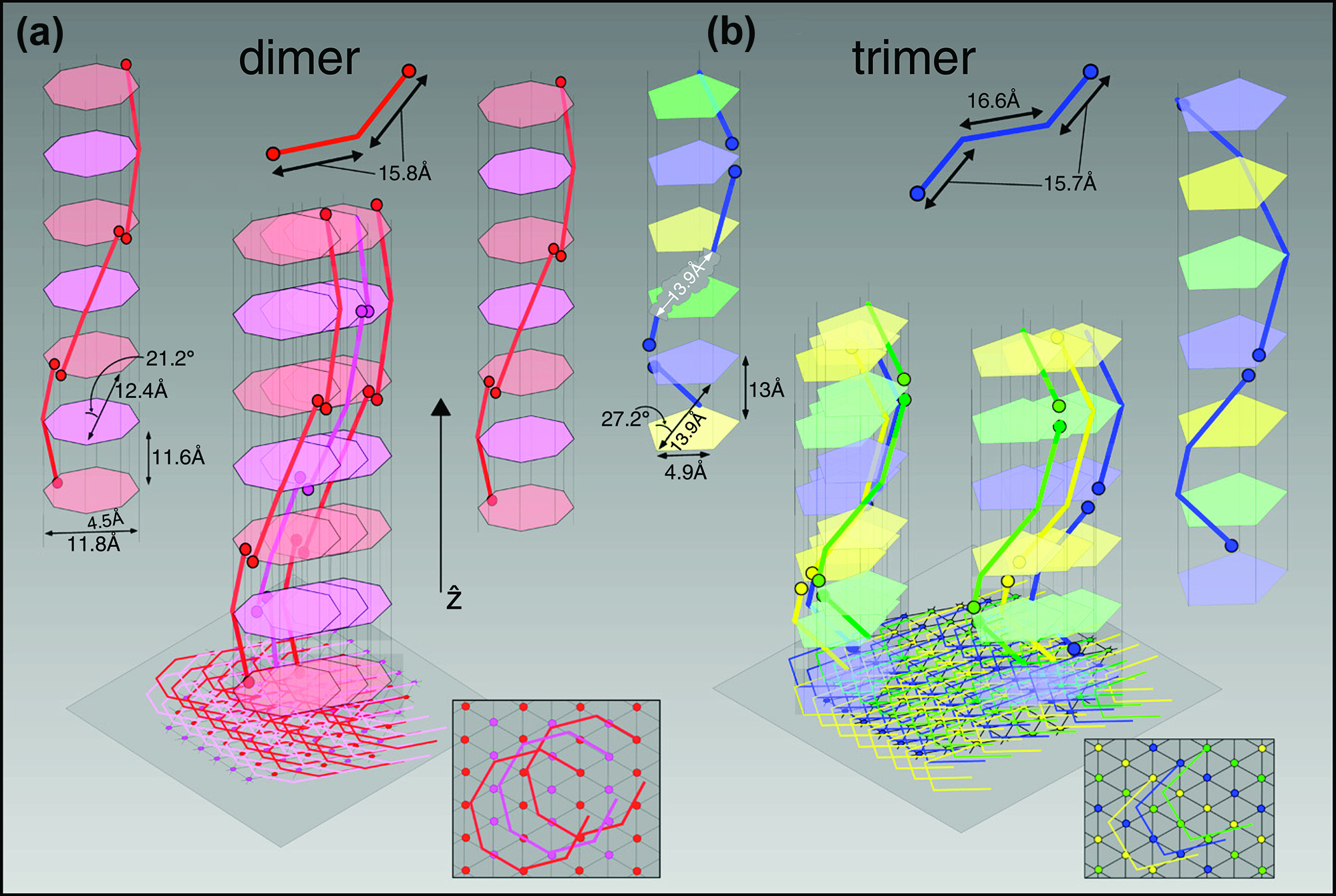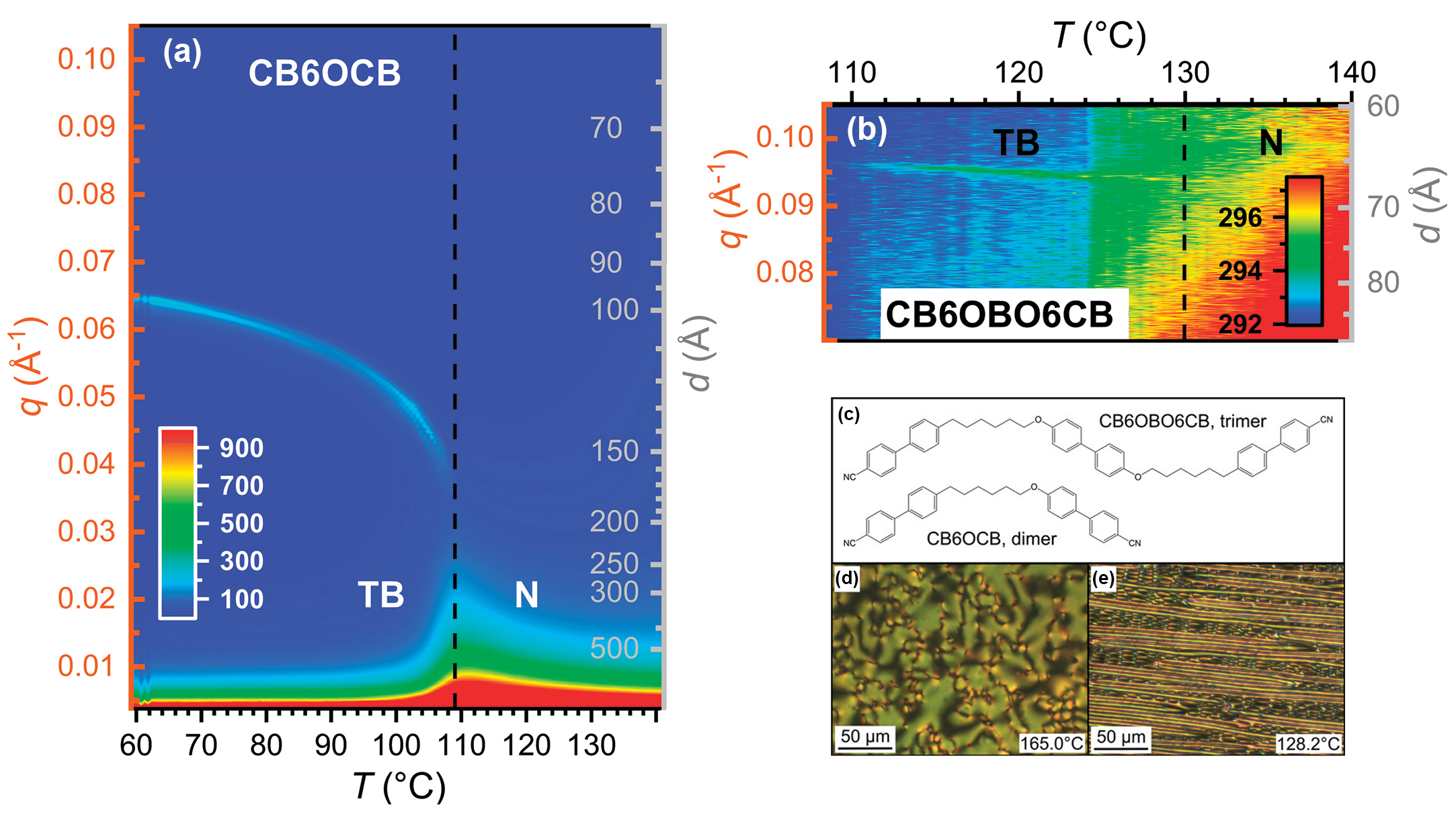SCIENTIFIC ACHIEVEMENT
At the Advanced Light Source (ALS), researchers untangled connections between structure and behavior in a class of liquid crystals consisting of flexible, chain-like molecules that self-organize into twisting patterns.
SIGNIFICANCE AND IMPACT
The study opens up new possibilities for designing novel liquid-crystal molecules that allow greater control of nanoscale behavior for technological applications.

Liquid crystals with a twist
The type of liquid crystal that enabled the development of modern flat-panel displays was originally discovered over 130 years ago. “Nematic” liquid crystals consist of rod-shaped molecules that align their long axes but are not fixed into lattices or layers. Their technological utility stems from their large susceptibility to electric or magnetic fields, light, and temperature. In flat-screen displays, for example, electric fields reorient the molecules to block light or let it pass.
In 2011, scientists identified an intriguing new subgroup of the nematic phase: the twist–bend nematic, in which bent molecules form a twisting, helical nanostructure in the liquid crystal. If the bent molecules consist of a number of identical rod-shaped subunits (monomers) connected by bendable linkers, their inherent flexibility could have profound effects on the overall behavior of the liquid crystal. Despite many studies about the twist–bend nematic phase, there are still many unknowns about the nature of its nanoscale organization and behavior.
Trimers and dimers
In this work, a group of researchers wanted to find out how increasing the number of monomers in a molecule that forms the twist–bend phase influences the properties of its nanoscale helix. For example, how does having three monomers as opposed to two (i.e., trimers vs dimers) affect the liquid crystal’s helical pitch—the distance to complete one turn?
To address such questions, the researchers synthesized a trimer (CB6OBO6CB) based on an analogous, previously studied dimer (CB6OCB). They then compared the results of a number of nanoscale characterization techniques, including resonant soft x-ray scattering (RSoXS) and wide-angle x-ray scattering (WAXS) at the ALS.
Probing changes in pitch and phase
At ALS Beamline 11.0.1.2, the sensitivity of the RSoXS technique to molecular bond orientations at the carbon K-edge provided a direct measure of helicity in the twist–bend nematic phase. In addition, WAXS experiments at Beamline 7.3.3 enabled the researchers to probe electron-density modulations in the samples, and thus were a powerful tool for studying phase transitions between the liquid, liquid-crystal, and crystalline phases.
On a microscopic scale, the twist–bend phases of the dimer and trimer appear essentially identical. However, the results showed that the dimer’s helical pitch increased from 100 to 170 Å upon heating, while the trimer’s pitch remained essentially constant at 66 Å. This value is also significantly shorter than those reported for other twist–bend materials in the literature.

A model of interlocking helical chains
The researchers attributed the differences to a combination of the trimer’s intrinsic bend configuration and a good intercalating fit between trimers over a significant fraction (two-thirds) of their length. Based on the results, the group developed a model of these materials with fully determined geometric parameters.
The work advances the possibility of designing liquid crystals for applications in which a fixed pitch over a wide temperature range is preferred, such as nanotemplating or chiral separation techniques. It also opens up a rich phase space of possible molecular design motifs for the twist–bend phase by not only varying the chemical makeup and number of monomers, but also by varying the physical dimensions and orientations of the monomers, to yield further exciting material properties.
Contact: Chenhui Zhu
Researchers: M.R. Tuchband, A.N. Scarbrough, D.M. Walba, and N.A. Clark (University of Colorado Boulder); D.A. Paterson, E. Forsyth, J.M.D. Storey, and C.T. Imrie (University of Aberdeen, UK); M. Salamończyk (Kent State University and ALS); V.A. Norman, C. Wang, and C. Zhu (ALS); E. Garcia (Universidade de Brasilia, Brazil); and S. Sprunt and A. Jakli (Kent State University).
Funding: National Science Foundation. Operation of the ALS is supported by the U.S. Department of Energy, Office of Science, Basic Energy Sciences Program.
Publication: M.R. Tuchband, D.A. Paterson, M. Salamończyk, V.A. Norman, A.N. Scarbrough, E. Forsyth, E. Garcia, C. Wang, J.M.D. Storey, D.M. Walba, S. Sprunt, A. Jakli, C. Zhu, C.T. Imrie, and N.A. Clark, “Distinct differences in the nanoscale behaviors of the twist-bend liquid crystal phase of a flexible linear trimer and homologous dimer,” PNAS 116, 10698 (2019), doi:10.1073/pnas.1821372116.
ALS SCIENCE HIGHLIGHT #399